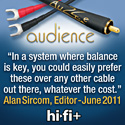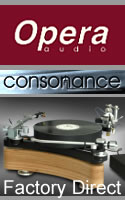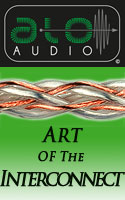|
|
You are reading the older HTML site
Positive Feedback
ISSUE
58
herron audio VTSP-3A Preamplifier and the M1 Amplifiers as reviewed by Karl Lozier
Going to Herron Audio's web site revealed a previous review by me. I stand by everything I wrote then and realize that a bit of background would be logical. Also expansion with evaluation of the latest efforts by Keith Herron and the resultant upgraded products need to be presented with some detailed listening results. His perfection approach to designs means time and more time to use and evaluate all possible new component parts right down to the smallest capacitors and resistors. Do not expect to see some brand names for parts; promotion of them does not interest him. Listening to those parts is all that counts. I believe that he made approximately fifty-two new parts changes in this latest upgraded tubed preamplifier. That takes a great deal of time and experimentation. If he was working as product design engineer for some large corporate companies, they might have him figuring out how to make these components almost as good, though much more easily and cheaper.
In my experience over too many years now, only when the owner is the audio engineer does a product get worked on over a very long time and seemingly just gets better and better. Other times the designer-owner gets tired and sells out, and his product just gets stuck in place, and disappears eventually. Think about that when you hear about company changes; there are plenty of examples. Keith's background is solid; he has an electrical engineering degree from Iowa State University and extensive design experience in the commercial audio field. I bet that is where he got the idea that components need to be trouble-free by design and always expected to function correctly. I know that he likes the sound of well designed tubed components, and I have a feeling that the reason his amplifiers have so far been solid-state designs, is that in the commercial field it is so common to eventually have unexpected problems with tubed amplifiers. That has been true with me and my limited experiences with tube amplifiers received for review. Remember a few years ago the phrase 'straight wire with gain' applied to many solid-state amplifiers with vanishingly low levels of distortion? It rarely described preamplifiers. So it is a small step to take that "almost perfect amplifier," and feed that beautiful tube preamplifier output to it, and 'Presto' there's tubed sound coming from the solid-state amplifier—right? I must admit that I kind of lean that way. Of course Keith seems to like a neutral sound quality that is not easily labeled as tubed or solid-state. And that more than ever is true with the new M1 power amplifiers as well as the superbly performing tubed VTSP-3A preamplifier. It should be mentioned that Keith has also performed as a musician (drums being his choice) and he and his wife are regular attendees of classical concerts at Powell Hall, one of the few newer centers with good acoustics.
More than ever, Herron's latest electronics seem to let the music just flow out of them in an extremely natural way. The latest version of his tubed preamplifier still seems to more nearly capture the beauty, sense of life, dynamics, natural details, and microdynamics than the expected presence, body, and power of the latest version of the solid-state amplifiers. Though never seemingly strained with anything I needed them to do, I could imagine that some loudspeakers that present an unusually tough load to deliver maximum output in the bass range, possibly needing 300 to 400 watts into a low impedance load, though rather rare, would simply not be handled as well by the M1s. What is rare and taken care of easily by Herron's amplifiers is that when not receiving a signal, they are then simply cool to the touch; almost none of that wasted heat as from my old favorite Class-A type solid-state amplifiers. In fact, I seldom turn them off. In the now many years of using Herron electronics I can only remember one problem. That was a preamplifier tube becoming noisy after a few months and easily swapped out. I can now simply use and listen to Herron's amplification equipment, and have no need to compare with anything else. It is my reference standard, and though prices have snuck up some over the years, caused by consumer demand for remote control, more attractive case and so on, I believe it is the only audibly competitive equipment to start in the ten to twelve thousand dollar range. The proven value is definitely there. So far nearly every improvement has been available in the preceding model at a fair price. The audio quality has made my search for outstanding source components so much easier. There are very few really excellent SACD and CD players, and the various faults are rather quickly revealed played through Herron's low distortion, highly detailed audio quality components. As most of our readers know, I mainly review recordings, and in particular high resolution releases such as SACD and Blu-ray. Many of the newer releases played with the best players, and the very best amplification components such as these by Herron Audio, often reveal seemingly no obvious audio faults or problems! Yes, it does seem as though if there is accompanying video, it somehow tends to mask certain audio qualities, requiring listening without viewing at times. One thing that seemed to be missing here is the fact that both Herron components seem to be very neutral and natural sounding. Quite a bit of being neutral refers to tonal balance characteristics. I do not mean to imply that there is some synergistic effect with these outstanding components, and to say that they complement each other is not quite correct either. So few components are actually tonally neutral that to use either the VTSP-3A or the M1 amplifiers with other components may not allow their unique beautifully neutral tonal balance to be appreciated. So my recommendation is when auditioning either one, make every effort to audition them together, even if you only need one of them, sooner or later you will want both of them. Karl Lozier It is now time, or even past time, to ask Keith Herron to discuss why or how he decided to upgrade his quite excellent preamplifier and power amplifiers, and what areas received the most attention. Are there any plans to do it all again and if so, what or why? Additionally, I would like Keith to discuss a situation that has been bothering me for the past few years. Someone has started an acronym that makes no sense to me and /or is redundant. The acronym is 'PRAT' for Pace, Rhythm, and /Attack, Timing. I think all important is simply 'Timing' and the others are basically descriptions of or for Timing. Karl: What made you want to change the VTSP-3 and what is this 'Timing' thing people talk about? Keith: The things I listen for when evaluating the performance of an audio system are timing and colorations. Timing is the quality of an audio system that resolves events in proper order of time, and provides articulation and that sense of live music. Many things have to be right in order for the timing to be precise, including flat frequency and phase response (using Fourier Series Mathematics), and also resonances and distortion must be minimized. Frequency response along with square wave and pulse response can easily be evaluated on the test bench. Other factors such as component resonant colorations must be evaluated by ear. I am always in the pursuit of perfection when it comes to audio recording and playback, and in that quest I am constantly evaluating the performance of audio circuits and components. Karl: How is the VTSP-3A different from the VTSP-3? Keith: There are over 50 changes in the circuitry of the VTSP-3 incorporated into the VTSP-3A version. The modifications range from analog circuit changes to power supply tuning adjustments that lower the high voltage regulator output impedance and make the supply rock solid during all operating conditions. The four stage high voltage regulator section ensures that the high voltage tube supply stays exactly the same even with variations of incoming power line voltage and large amplitude audio signals. Power supply circuit resonances are neutralized in order to eliminate colorations that would alter the natural character of the sound. Many parts in the analog section and power supply were replaced with identical values of new parts that have less of a sonic signature. This type of signature is typical of many "audiophile" and "non-audiophile" parts, and in most cases it varies significantly with value, physical size, mass, and voltage or wattage rating. Parts selection is critical, and the types I use depend on where it is in the circuit, and each part's precise affect on the total sound of the unit. Every part in the unit has been evaluated for its sonic contribution. Finding exactly the right part for each location in the circuit is the thing that is absolutely crucial. The analog section was optimized for minimum distortion (well under 0.01% at 2.45 volts r.m.s. output, with a good set of tubes) and low noise. The improvements are immediately obvious with superior articulation and clarity top to bottom, more expansive soundstage, improved micro dynamics, and air. It brings you much closer to the original performance with that "you are there" sense of live music. There is an additional circuit board added to the 3A version along with other changes. The VTSP-2 and VTSP-3 can be factory upgraded to a VTSP-3A. Karl: What are the changes to the M1 Monaural Power Amplifiers? Keith: As I learn new audio circuit optimizations in the process of improving the VTSP-3 to the VTSP-3A, and with other audio projects, I often find that some of the new approaches that I have learned apply to our other products, and such is the case with the M1 amplifier. The M1 was based on the M150 (150 watt at 8 ohm, 275 watt at 4 ohm monoblocks) which we first produced in 2000, and it has gone through a number of improvements and refinements, along with cosmetic changes, since that time. The latest changes to the M1 involve the addition of a few parts in the control circuitry and the replacement of some parts in the front end, and pre-driver stage, to improve the timing and increase the soundstage, focus, transparency, bass, dynamics, air, and resolution. Karl: Well, Keith that seems to be at least a little bit of every thing though I would imagine some changes affected more than one thing, as many audio qualities are so intimately intertwined. Now with long term use of both of your new components, the VTSP-3A and a pair of the M1 amplifiers I am completely satisfied and am unable find fault (and I really tried). Addendum Nowadays, because of limiting my reviewing to mostly music/recordings, I do not have so much in the way of really top notch or potential top components other than players to use for comparisons. Allen Wright, designer of the internationally well known VSEI tubed electronics, and more recently the continuing series of ultimate solid-state upgrades to SACD players, called asking me to review his newly developed tubed preamplifier, almost a rarity in the USA. My first-hand knowledge of his dedication to creating the best sounding SACD player is clear by my ownership of three of his most recent efforts. So tempting to have the privilege or challenge I ultimately declined as I was afraid that I simply did not have the months of time available as I was ending this review and did not want to get caught between deciding which of two world class preamplifiers was the better for listening to music, and Allen Wright's latest player upgrade would have been the source used for deciding though it does not use tubes. Sadly and unexpectedly, Allen passed away just a few months after that ending a very interesting coincidence.
VTSP-3A Preamplifier
M1 Power Amplifiers
Herron Audio
|








